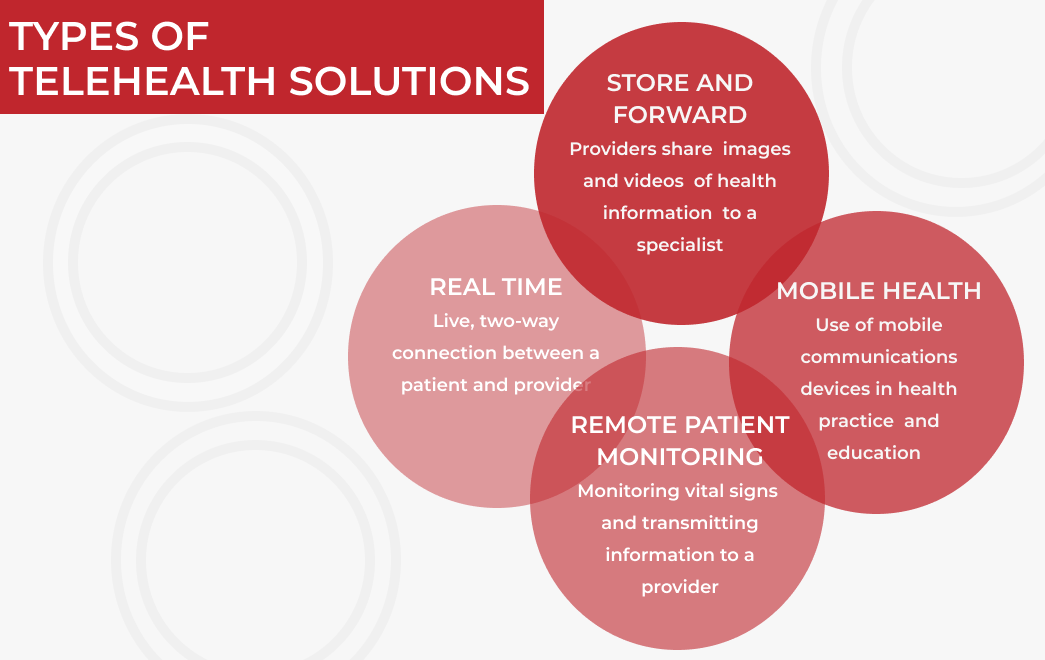Telehealth Solutions: Types and Application


What is Telehealth?
Innovation has helped improved a lot of aspects in people’s daily lives and including advanced technical solutions in the medical field. Medical practitioners have started using telehealth that encompasses videoconferencing, remote monitoring, electronic consultations and wireless communication between healthcare providers and consumers of the service.
According to new surveys and reports, telehealth is slowly paving its way to implementing in hospitals and health systems. From 54% in 2014, it reached 85% in 2019. Remote patient monitoring through clinical-grade devices has increased the usage from 8% in 2016 to 14% in just three years. In another research, 70% of health organizations use mobile and patient digital health tools, 67% opt for tools maximizing emails, texts, phone reminders, scheduling, appointments and payments.
Slowly but surely, people started to realize that telemedicine app development solution is a lot easier to use and is more cost-effective for medical, health or staff training purposes.
A Closer Look at Telehealth Solutions
Telehealth solutions help healthcare providers give out relevant information, training, and services remotely with applying various telecommunication tools. Healthcare professionals might also start using telehealth to train healthcare staff, provide health information to patients for preventive health measures or even remotely monitor the patient’s progress and recovery after hospital confinement discharge. Telehealth aims at healthcare practices improvement through patient engagement that can become more accessible, especially in regard to reaching the remote parts of the United States as well as worldwide.
Aside from accessibility, the benefits of telehealth include being able to assist healthcare organizations, clinics, and hospitals under the circumstances of staff shortage. It can also provide better training guides and materials that may be universal and standard for all since it can be accessible over the internet. Healthcare providers can also establish a harmonious relationship with their patients because their needs are attended to in a very convenient manner. Overall, telehealth provides great benefits for both healthcare providers and patients with its more efficient environment.
Telehealth and Telemedicine
Though both telehealth and telemedicine serve healthcare and well-being maintenance, it is different in a few different ways. Telehealth focuses on a broader range which involves sharing information and health services in staff training, community members and patients while telemedicine only focuses on connecting patients and physicians for satisfying their medical needs and addressing concerns.
It is easier nowadays to get the treatment and medical attention you need but oftentimes, it can be challenging for those living in rural areas. Community hospitals in isolated areas have a very limited budget and do not have resident specialists, thus, making it hard for patients in need for treatment or help in special cases. Telehealth benefits turn this situation around by providing support and immediate care like neonatal, neurology and cardiology needs by using technology and communication over audio-video devices.
Here are several healthcare specialties that can deem helpful in the long run by ensuring quality in providing health service via telecommunication technology means:
Telepsychiatry
One of the most complex branches in healthcare is psychiatry. In telepsychiatry, patients and those in need of psychiatric help or mental health improvement will be provided assessment care via telecommunications technology by applying videoconference tools. All over the world, access to proper psychiatry can be challenging and is considered a huge struggle not to mention the lack of psychiatrists nearby and treatments being more expensive. That’s why telepsychiatry development is promising given that it is a more affordable, patient-centered and effective innovation for struggling individuals. Apparently, people can address mental health problems more effectively by applying telepsychiatry development solutions.
Telehealth Nursing
Telehealth nursing was developed to conduct help via telemedicine and technology for the communities located in rural areas. With the use of telehealth nursing, it is easier to monitor the conditions of patients and interact with them using audiovisual technology. Nurses can easily monitor oxygen levels, heart rate, respiration, and blood sugar levels. Aside from that, nurses can also provide help in first aid and minor health needs to patients including instructions on basic medical needs.
Telecardiology
Attaining remote diagnosis and treatment for heart disease is made practical and easy with Telecardiology, or the use of telecommunication for chronic and acute coronary heart disease, arrhythmias, congestive cardiac failure, and cardiac arrest. Telecardiology enables cardiology specialists to provide aid, especially in remote locations and rural areas. This has not just been accessible but also improves the clinical training of practitioners while reducing the percentage of missed cardiac events allowing for real-time detection and immediate medical attention.
Women’s Telehealth
Women in rural communities have continuously struggled to get the proper healthcare they need. There’s a shortage of OB-GYNs in rural areas. Hence, there is a lack of medical attention when it comes to transitional times such as puberty, pregnancy, and menopause. This is why telehealth for women is important. Aside from being accessible, the usage of telecommunication technology has improved information sharing and support to sexual and reproductive health needs with its more convenient consultations, feedback and assessment providing emotional and health support to women all over the world. Physicians can easily instruct and give helpful information to their patients when it comes to different women’s health needs such as pre and post-natal care, breastfeeding, postpartum depression screenings, and hormonal fluctuations.
The Types of Telehealth Solutions
There are different ways to share information and engage with healthcare providers and patients. Below, there is a list of four telehealth solutions types for deeper understanding telehealth concept.

1. Store and Forward or Asynchronous Telehealth
It allows patients and healthcare providers to share images and videos of health information while being remote. It surely assists physicians in studying cases and checking medical conditions without making the patient’s presence mandatory. This solution is being widely used in radiology, dermatology, and ophthalmology, given that in these specialties the diagnosis can be conducted by studying the photos or videos sent by the patients. This solution also helps address health needs more efficiently.
2. Remote Patient Monitoring or Telemonitoring
This allows nurses and physicians to monitor the patient’s health and progress. Patients with diabetes can have their blood sugar levels easily monitored to avoid health complications. Patients who are recently discharged from confinement or even patients who are recovering from minor illnesses can easily be monitored as well. With Remote Patient Monitoring, patients and their healthcare providers can easily be in constant communication to promote health improvement and risk prevention.
3. Mobile Health Solutions
Since the majority of the population use smartphones and electronic devices that allow application downloads and installations, mobile health technology has paved the way for creating technologically advanced healthcare solutions. Health providers can easily disseminate information, provide public health programs while engaging and educating users and patients.
4. Real-Time or Synchronous Telehealth
With video calling, real-time telehealth solutions are easy to apply. This is the nearest substitute to the usual in-person doctor-patient communication. With Real-Time telehealth, patients can be monitored in terms of assessing their condition by doctors. This helps fix quick consultations for treating minor illnesses. It also works well in follow-up check-ups and preventive measure reminders for patients.
These types of telehealth solutions provide medical assistance and save time and money compared to the conventional healthcare especially for those located in rural areas.
With the use of telehealth, healthcare gets more accessible and affordable for all. Moreover, it provides quality and supplies information not just to the patients but to those in the medical field. Thus, it is aimed at giving medical assistance to everyone. Nowadays, information about health and maintaining patients’ well-being turns out to be at arm’s length, which leaves no excuse to be a better and healthier version of yourself.
Build your ideal
software today

